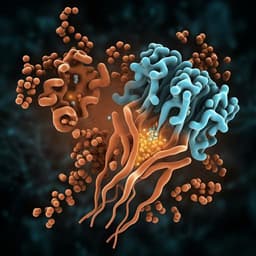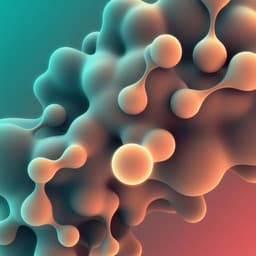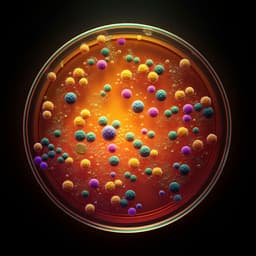
Agriculture
Fermentative profile, losses and chemical composition of silage soybean genotypes amended with sugarcane levels
A. D. M. Zanine, O. A. D. Sene, et al.
Discover the groundbreaking research conducted by Anderson de Moura Zanine and colleagues, revealing that silage from four soybean genotypes, particularly C50, achieves optimal fermentation and nutrition profiles when combined with 25-50% sugarcane. This study highlights the exciting potential for enhancing livestock feed through innovative agricultural practices.
~3 min • Beginner • English
Introduction
The study addresses the challenge of producing high-quality silage from soybean plants, which as a legume have high crude protein, low water-soluble carbohydrates (WSC), and high buffering capacity. These traits slow pH decline during ensiling and predispose to undesirable fermentations (e.g., clostridial), increasing butyric acid and ammoniacal nitrogen. Climate variability can also reduce grain yield and seed viability, making whole-plant soybean for silage an attractive alternative. Sugarcane, rich in WSC but low in crude protein and minerals and prone to ethanol production, could complement soybean in mixed silages by supplying fermentable substrates for lactic acid bacteria. The research question was whether including sugarcane at different levels with various soybean genotypes improves fermentative characteristics, reduces losses, and enhances nutritional composition and digestibility of the resulting silages. The purpose was to identify inclusion levels and genotypes that optimize fermentation and nutritive value, with practical importance for ruminant feed production under variable climatic conditions.
Literature Review
The paper references prior work showing: (a) legumes’ high protein and buffering capacity hinder rapid pH reduction and lactic fermentation, promoting undesirable fermentations; (b) sugarcane’s high WSC can fuel lactic fermentation but also increase ethanol losses due to yeasts; (c) mixed silages of grasses and legumes can balance traits, improving fermentability and protein content; (d) sugarcane maturity, season of harvest, and use of additives influence WSC levels, ethanol production, and dry matter recovery; and (e) acceptable thresholds for pH and ammoniacal nitrogen in silage exist (e.g., N-NH3/NT <10%). These studies support the hypothesis that combining soybean with sugarcane at appropriate ratios can enhance fermentation, reduce losses, and maintain nutritive value.
Methodology
Design: Completely randomized design in a 4 x 5 factorial arrangement with four replicates (total 80 silos). Factors were four soybean genotypes (Pampeanas C50, C60, C70, and BRS 333 RR) and five sugarcane inclusion levels (0, 25, 50, 75, 100% of natural matter).
Site and crops: Conducted at the Center for Agricultural and Environmental Sciences, Federal University of Maranhão, Chapadinha, Brazil (Aw climate). Soybean genotypes were from commercial areas in partnership with UFMA (3.6°86' S, 43°14' O). Sown January 2017 at 0.50 m row spacing, 13 plants per meter (≈260,000 plants/ha). Rainfall during crop cycle was 640 mm. Harvested at 75 days after planting at R-5:3 stage by cutting plants 10 cm above soil. Sugarcane was planted at 0.8 m inter-rows, harvested at 18 months.
Silage preparation: Soybean and sugarcane chopped to ≈2 cm, weighed, and mixed by hand to assigned inclusion levels. Experimental silos: polypropylene buckets (capacity ≈3.5 kg). Each had 1 kg sand at bottom (for effluent collection) separated by cotton fabric. Lids with Bunsen valves ensured anaerobiosis and gas release. Silos stored for 70 days at 25±2 °C.
Measurements:
- Losses and recovery: Gas losses (GL), effluent losses (EL), and dry matter recovery (DMR) assessed per Jobim et al. (2007). DMR = (FMo × DMo) / (FMs × DMs) × 100, where FMs/DMs are mass and DM at sealing; FMo/DMo at opening.
- Chemical composition: Dry matter (DM; AOAC 934.01), mineral matter (MM; AOAC 930.05), crude protein (CP; Kjeldahl AOAC 981.10), neutral detergent fiber (NDF) and acid detergent fiber (ADF) per Van Soest/Robertson methods. Hemicellulose = NDF − ADF.
- Fermentation profile: pH (25 g in 75 mL water, 30 min, potentiometer). Ammoniacal-N (N-NH3/NT) via extraction with 2 mol/L KCl, MgO distillation and titration. Organic acids (lactic, acetic, propionic, butyric) and ethanol via HPLC (Shimadzu SPD-10A VP, UV 210 nm) following Siegfried et al. methodology. Water-soluble carbohydrates (WSC) determined per standard methodology. In vitro DM digestibility (IVDMD) by two-stage technique: 0.5 g sample incubated 48 h with McDougall’s solution and rumen inoculum, then 48 h with 0.2% pepsin at 39 °C; IVDMD calculated accordingly.
Statistical analysis: ANOVA with regression (orthogonal contrasts) using SAS PROC GLM and PROC REG. Significance at 5%. Interaction effects between genotypes and sugarcane levels assessed. Pre-ensiling composition of genotypes and sugarcane reported to contextualize results.
Key Findings
- Fermentation acids and nitrogen: Strong interactions (P<0.001) between sugarcane level and genotype for lactic acid (LA), acetic acid (AA), LA:AA ratio, propionic acid (PA), butyric acid (BA), ethanol, and ammoniacal nitrogen (N-NH3/NT).
• LA increased quadratically with sugarcane inclusion, peaking at intermediate levels: maxima around 50–75% sugarcane depending on genotype (e.g., BRS ≈17.03% at 50%; C70 ≈18.79% at 75%). C70 showed higher mean LA.
• AA generally highest at 100% sugarcane; exception: C60 peaked at 75% sugarcane (≈4.65%). C60 had higher mean AA.
• LA:AA ratio peaked at 25% sugarcane for BRS, C60, C50 (≈11–16), and at 50% for C70 (≈14–16). C70 had higher average LA:AA.
• PA showed negative quadratic responses with minima at low-to-intermediate inclusion (e.g., ≈0–0.23%). C70 and C60 had higher average PA.
• BA decreased with sugarcane; pure soybean silages had the highest BA. C70 had the highest mean BA; C60 showed a linear decrease with sugarcane.
• Ethanol exhibited quadratic responses: BRS and C70 increased to maxima at higher inclusion (≈3.01 and 4.91% at 75%), whereas C60 and C50 showed minima at 25% inclusion (≈0.54–0.64%). C70 had the highest mean ethanol.
• N-NH3/NT decreased (negative quadratic) with sugarcane across all genotypes. Highest at 0% sugarcane (≈10.27%), lowest at 100% sugarcane (≈0.30%); at 25–75% inclusion, values were <5%. BRS and C70 showed higher means for N-NH3/NT.
- pH, losses, and DMR: Interaction for pH and gas losses; effluent losses unaffected by levels or genotypes.
• pH decreased with sugarcane: for C70, a negative quadratic effect with minimum around pH 3.40; others showed linear decreases. Pure sugarcane silage averaged pH ≈3.40.
• Gas losses: C60 showed no significant effect; BRS and C70 increased linearly with inclusion; C50 had a quadratic response with lowest GL at 25% sugarcane (≈2.27 dag/kg DM). Inclusion level means were similar (≈10% of DM), with higher values at 75% sugarcane (≈13.12 dag/kg).
• Dry matter recovery (DMR) showed positive quadratic responses, highest at 25–50% sugarcane (≈93.05–95.29%); overall range 83.28–95.71%.
- Chemical composition and digestibility:
• DM content showed quadratic increases peaking at 25% sugarcane for BRS (≈20.40%) and C50 (≈19.93%); C60 unchanged; C70 decreased linearly.
• MM decreased linearly with sugarcane for all genotypes; highest MM in C70 silages (≈7.96%).
• CP declined with higher sugarcane. BRS decreased linearly; C70, C60, and C50 showed quadratic peaks at 75%, 25%, and 25% sugarcane, respectively (maxima ≈6.85%, 6.76%, and 12.17%). C50 had the highest mean CP (≈7.57%). Overall CP across treatments varied roughly 4.60–7.48% as highlighted in the abstract.
• NDF increased with sugarcane level; 100% sugarcane had the highest NDF (≈56.82%). BRS 333, C60, and C50 had lower mean NDF than C70; ADF varied by genotype with BRS showing the lowest mean ADF (≈34.90%).
• WSC increased linearly with sugarcane for all genotypes (e.g., ≈4–5% at 0% to ≈20.5% at 100%).
• IVDMD showed quadratic responses to inclusion; higher averages were observed in some genotypes at intermediate inclusion. C50 ranked among the highest for IVDMD, indicating better digestibility preservation.
- Overall optimal range and genotype performance: The 25–50% sugarcane inclusion range optimized fermentation (higher LA, favorable LA:AA, lower BA and N-NH3/NT), minimized losses (higher DMR, controlled ethanol and gas losses), and supported higher CP and IVDMD. Among genotypes, C50 stood out with superior CP, favorable fermentation (lower N-NH3/NT), lower fiber, and higher digestibility metrics.
Discussion
Adding sugarcane supplied fermentable WSC that stimulated lactic acid bacteria, increased lactic acid, and reduced pH, improving fermentation compared to pure soybean, which due to high buffering capacity and protein content showed higher pH, butyric acid, and ammoniacal nitrogen indicative of clostridial/secondary fermentation. However, excessive sugarcane (≥75–100%) increased ethanol production and gas losses, likely from yeast fermentation of abundant sugars, and reduced dry matter recovery. Mixed silages balanced these effects: at 25–50% sugarcane, lactic fermentation was promoted while acetic acid helped suppress yeasts, keeping ethanol moderate, reducing N-NH3/NT to acceptable levels (<10%), and maximizing DMR. Nutritionally, higher sugarcane decreased CP and increased fiber relative to soybean, but within the optimal inclusion window, silages maintained better CP and digestibility (IVDMD) while achieving stable fermentation. Genotype differences were evident: C50 consistently showed higher CP, favorable fermentation (lower proteolysis, lower N-NH3/NT), lower fiber, and high IVDMD, suggesting better preservation of nutritive value under the tested ensiling conditions. Collectively, these results address the research objective by demonstrating that targeted sugarcane inclusion can correct the fermentation challenges of soybean silage without incurring the ethanol-related losses seen in high-sugarcane silages.
Conclusion
Inclusion of sugarcane at 25–50% with whole-plant soybean optimizes fermentation (higher lactic acid, favorable LA:AA, lower butyric acid and ammoniacal nitrogen), maximizes dry matter recovery, and supports higher crude protein and digestibility. Among the genotypes, C50 was superior, combining better fermentative stability with higher biomass and nutritive value. Future work could validate these findings at farm scale across seasons and explore additives or inoculants to further refine fermentation control.
Limitations
Related Publications
Explore these studies to deepen your understanding of the subject.







